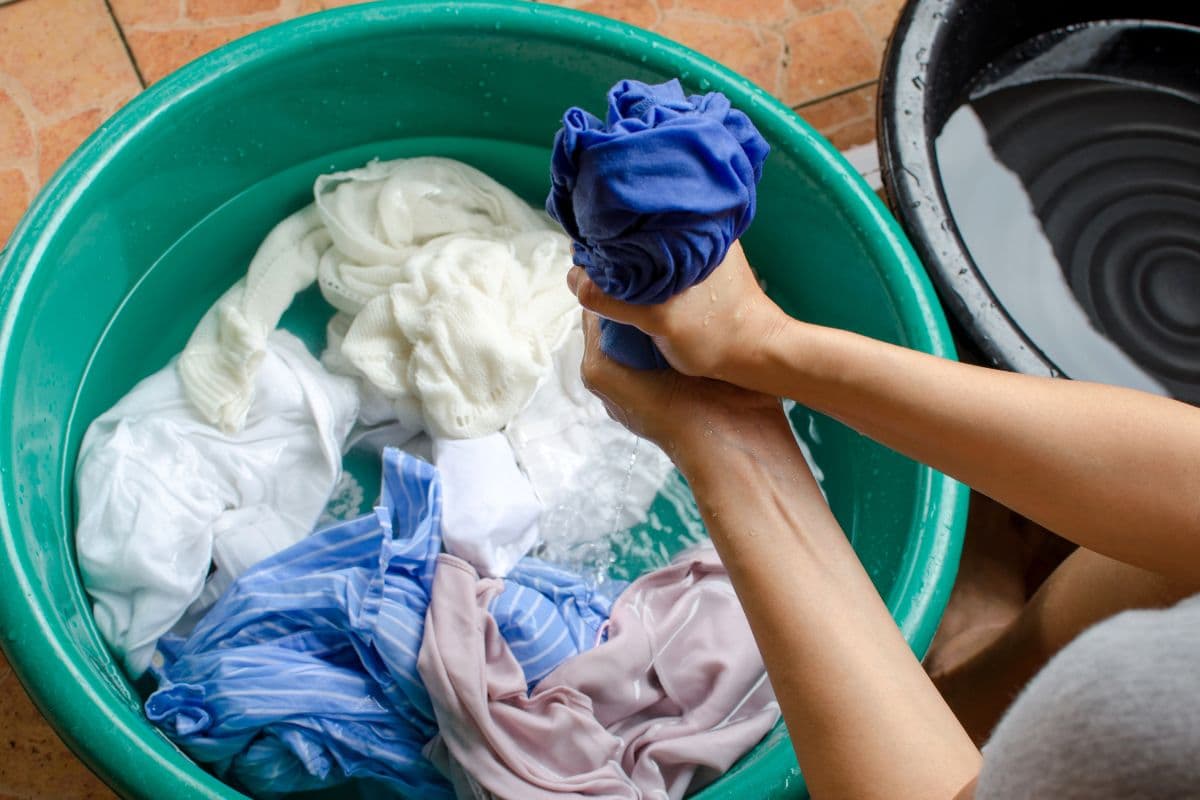Suppose you bought a lovely dress and wore it a few times. Now you need to wash the clothing, but the label says, ‘Do Not Dry Clean.’ We often see the tag on dresses, especially when it comes to cotton and linen fabric, but it’s not usually obvious what they mean.
‘Do Not Dry Clean’ means you should not use a dry cleaning agent when cleaning a clothing item in a dry cleaning machine. Instead, use water. Clothes usually have this label if their fabrics are delicate or they have dyeing chemicals.
In this post, I’ll explain the label and its meaning while guiding you through a detailed dry-cleaning process.

What Does ‘Do Not Dry Clean’ Mean?
Clothes and fabrics come with washing instructions on the label. Using various signs, icons, and texts, manufacturers recommend the most appropriate cleaning method for the customers.
A ‘Do Not Dry Clean’ label on fabrics is a simple recommendation to avoid dry cleaning the item. Instead, you must use another appropriate cleaning method to maintain the quality and longevity of the cloth. Using a hand or machine wash can also help some dyed fabric keep its color intact.
Many textiles are not suitable for dry cleaning. It is also best to avoid dry cleaning colored fabrics to avoid fading.
What Does Dry Cleaning Actually Mean?
Dry clean means using a special dry-cleaning solvent instead of water. Without water, the textiles are treated with wet chemicals to get them cleaned. Afterward, the wet clothes get dried in the machine before they are ready for ironing.
The liquid solvent dries off far more quickly than water, making it perfect for silks and wools. It is also excellent to remove stains and protect your glued buttons.
How Do You Wash ‘Do Not Dry Clean?’
You wash ‘do not dry clean’ clothes either by hand or with a washing machine. If you use a machine, don’t use a dry-cleaning agent. Instead, use water and normal detergent.
Home washing is less expensive than dry cleaning and helps delicate items last longer.
First, however, you should look closely at the label’s other symbols and icons to learn the most appropriate way. Deciphering those instructions will help you find the best cleaning method and help you decide:
- Whether to use cold or hot water.
- Which type of detergent to use.
- Whether to use natural dry or tumble dry.
What Fabrics Should Not Be Dry-Cleaned?
Natural cotton, synthetic fabrics, and delicate cashmere should not be dry-cleaned to maintain their color, structure, and aesthetics. It is also best to avoid dry cleaning cheap and thin materials, as they may not withstand the rigorous process.
Don’t dry clean the following materials:
- Natural Cotton: Cotton fabric doesn’t need dry cleaning. Instead, you can machine wash clothes made from preshrunk cotton before drying them naturally. You can also clean cotton with hand wash and detergents.
- Synthetic Fabrics: You shouldn’t dry clean artificial items like linen, polyester, nylon, acrylic, spandex, etc., to avoid shrinkage. Instead, use hand or machine wash. You can learn all about machine washing polyester from my blog, Does Polyester Shrink In The Washing Machine?
- Delicate Cashmere: The chemicals may prove too much for its sophisticated fiber if you dry clean cashmere, as it will accelerate the breakdown of the soft fibers over time.
- Inexpensive Items: While some affordable clothes are better suited for dry cleaning, ask yourself whether it’s worth the hassle. You don’t want to spend more on cleaning than the product’s price. Cheap fabrics are also prone to shrinkage or ripping off if dry-cleaned.
Is Dry Cleaning Really Necessary?
Dry cleaning is necessary for clothes that have the “Dry Clean Only” label and certain types of clothes like suits, which have fabrics that need protection from the sun and water.
Whether dry cleaning is necessary depends on the fabrics and types of clothes. When you buy a garment, inspect the label to learn if you need to dry clean it.
You must dry clean fabric if the label says, “Dry Clean Only,” or something along those lines. However, if a ‘Dry-Clean’ tag doesn’t mention ‘only,’ take it as a recommendation that doesn’t prohibit other washing techniques.
Dry cleaning is necessary for the following garment types:
- Tailored Items: Jackets, suits, coats, and other tailored clothes use different fabrics for the lining, padding, etc. They may also use hooked buttons, double bordering, unique stitching, etc. Therefore, tailored items should always be dry-cleaned. Using a machine or hand wash would damage their shape and accessories.
- Luxury Fabric: It is necessary to dry clean most silk, rayon, linen, and wool. Water is a solvent that can damage the delicate nature of these textiles and cause color bleeding. Besides, washing woolen products like sweaters and blankets at home is too complicated.
Moreover, if you have clothes prone to bleed with detergents, take them to your dry cleaners.
The Steps of Dry-Cleaning
A comprehensive dry-cleaning process includes the following steps:
1. Applying a Stain Remover
After tagging and inspecting your items, cleaners get busy applying a stain remover like chemicals, heat, or vacuum if there are spots in your garment. It loosens the stains and prepares them to be removed by the dry cleaning chemicals.
2. Organizing Similar Fabrics Together
Dry cleaning requires combining similar colors and fabrics for the best result. The cleaner goes through the care labels to understand the requirements before putting the clothes in a bag with the same color and similar instructions. It is also vital not to overweigh the bag.
3. Placing the Clothes in the Machine
The cleaner puts this bag into the dry cleaner with a standard clear solution which removes the dirt and cleans the cloth. It also involves drying the clothes with manufacturer-recommended instructions.
Once dried, cleaners use steam and ironing as appropriate to remove creases and wrinkles before packaging it for delivery.
Summary
Not all clothes can be washed in dry cleaning machines. These garments usually have a ‘Do Not Dry Clean’ message on their care label. It is best to abide by the cleaning instructions to make your fabric last longer.
Inspecting the materials and their quality can also suggest which fabrics are washable in dry cleaning and which are not. For example, cotton is best for home washing, while tailored suits should always be dry-cleaned.





